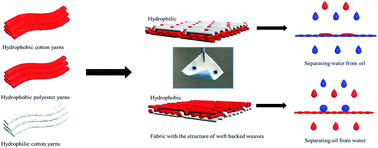Facile fabrication of asymmetric wettable fabric with weft backed weave for oil/water separation†
Abstract
Inspired by the special wettability of lotus leaves with high water repellence, the preparation of superhydrophobic materials has gained much attention. Herein, we report a new method to fabricate the fabric with weft backed weave that gains asymmetric wettability by fabric structure design. The fabric is made up of three types of yarns, in which hydrophobic polyester was applied as warp yarns, and both hydrophobic cotton and hydrophilic cotton served as weft yarns. Due to its asymmetric properties, as one face with a contact angle of ∼150° was superhydrophobic and repelled water and the other one was hydrophilic and absorbed water, the single-faced superhydrophobic fabric has been successfully used for oil–water separation to achieve water-removal and oil-removal. The separation of oil from oil/water mixtures could be achieved by placing the hydrophobic face on the top, and the switched separation of water from oil/water mixtures could be further realized by placing the hydrophilic face on the top after pre-wetting treatment. Moreover, each separation process has a separation efficiency above 95%.


 Please wait while we load your content...
Please wait while we load your content...